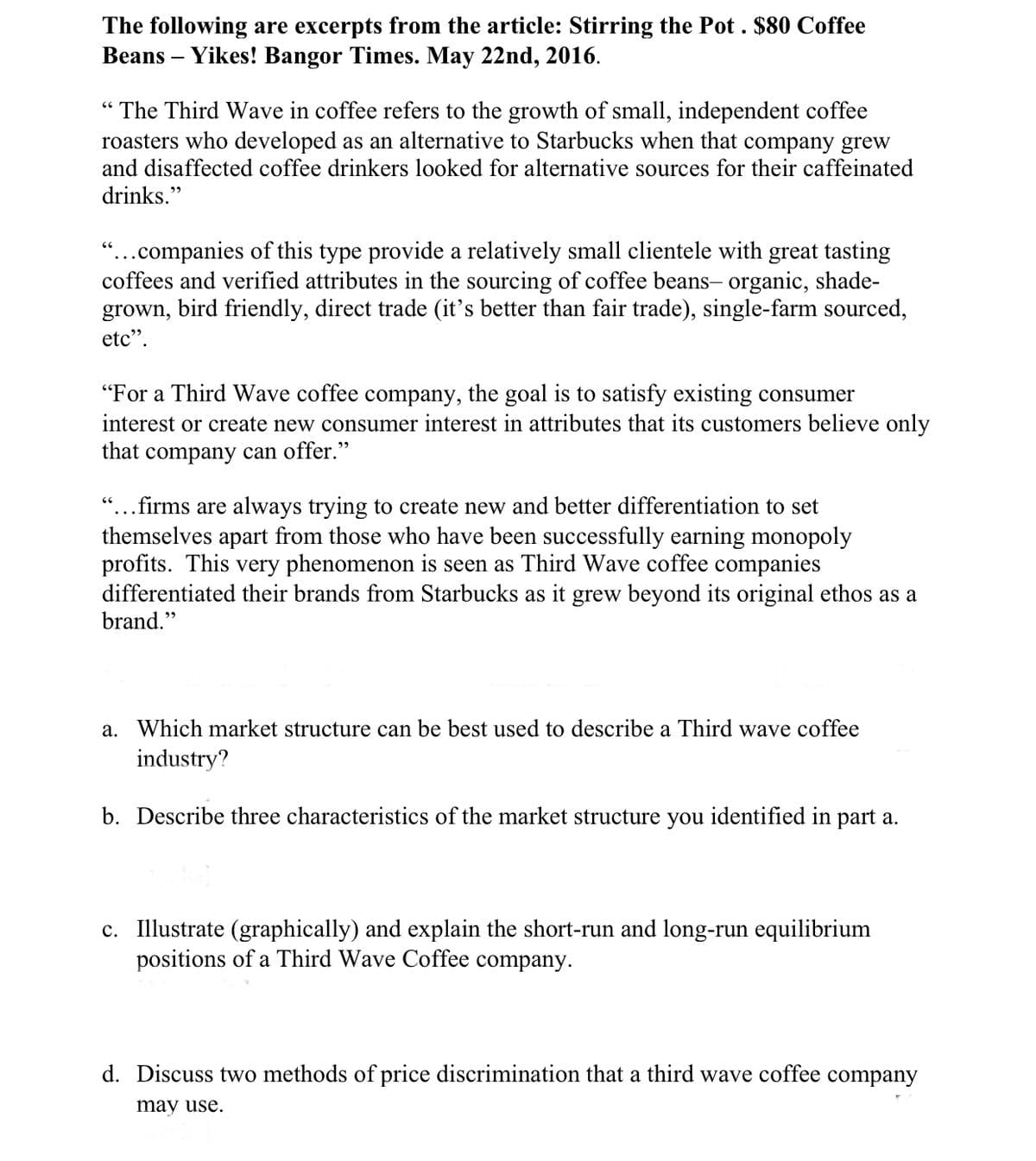The following are excerpts from the article: Stirring the Pot. $80 Coffee Beans – Yikes! Bangor Times. May 22nd, 2016. “ The Third Wave in coffee refers to the growth of small, independent coffee roasters who developed as an alternative to Starbucks when that company grew and disaffected coffee drinkers looked for alternative sources for their caffeinated drinks." "...companies of this type provide a relatively small clientele with great tasting coffees and verified attributes in the sourcing of coffee beans- organic, shade- grown, bird friendly, direct trade (it's better than fair trade), single-farm sourced, etc". "For a Third Wave coffee company, the goal is to satisfy existing consumer interest or create new consumer interest in attributes that its customers believe only that company can offer." "...firms are always trying to create new and better differentiation to set themselves apart from those who have been successfully earning monopoly profits. This very phenomenon is seen as Third Wave coffee companies differentiated their brands from Starbucks as it grew beyond its original ethos as a brand." a. Which market structure can be best used to describe a Third wave coffee industry? b. Describe three characteristics of the market structure you identified in part a. c. Illustrate (graphically) and explain the short-run and long-run equilibrium positions of a Third Wave Coffee company. d. Discuss two methods of price discrimination that a third wave coffee company may use.
The following are excerpts from the article: Stirring the Pot. $80 Coffee Beans – Yikes! Bangor Times. May 22nd, 2016. “ The Third Wave in coffee refers to the growth of small, independent coffee roasters who developed as an alternative to Starbucks when that company grew and disaffected coffee drinkers looked for alternative sources for their caffeinated drinks." "...companies of this type provide a relatively small clientele with great tasting coffees and verified attributes in the sourcing of coffee beans- organic, shade- grown, bird friendly, direct trade (it's better than fair trade), single-farm sourced, etc". "For a Third Wave coffee company, the goal is to satisfy existing consumer interest or create new consumer interest in attributes that its customers believe only that company can offer." "...firms are always trying to create new and better differentiation to set themselves apart from those who have been successfully earning monopoly profits. This very phenomenon is seen as Third Wave coffee companies differentiated their brands from Starbucks as it grew beyond its original ethos as a brand." a. Which market structure can be best used to describe a Third wave coffee industry? b. Describe three characteristics of the market structure you identified in part a. c. Illustrate (graphically) and explain the short-run and long-run equilibrium positions of a Third Wave Coffee company. d. Discuss two methods of price discrimination that a third wave coffee company may use.
Economics: Private and Public Choice (MindTap Course List)
16th Edition
ISBN:9781305506725
Author:James D. Gwartney, Richard L. Stroup, Russell S. Sobel, David A. Macpherson
Publisher:James D. Gwartney, Richard L. Stroup, Russell S. Sobel, David A. Macpherson
Chapter24: Price-searcher Markets With High Entry Barriers
Section: Chapter Questions
Problem 13CQ
Related questions
Question

Transcribed Image Text:The following are excerpts from the article: Stirring the Pot . $80 Coffee
Beans – Yikes! Bangor Times. May 22nd, 2016.
“ The Third Wave in coffee refers to the growth of small, independent coffee
roasters who developed as an alternative to Starbucks when that company grew
and disaffected coffee drinkers looked for alternative sources for their caffeinated
drinks."
"...companies of this type provide a relatively small clientele with great tasting
coffees and verified attributes in the sourcing of coffee beans- organic, shade-
grown, bird friendly, direct trade (it's better than fair trade), single-farm sourced,
etc".
"For a Third Wave coffee company,
the goal is to satisfy existing consumer
interest or create new consumer interest in attributes that its customers believe only
that company can offer."
"...firms are always trying to create new and better differentiation to set
themselves apart from those who have been successfully earning monopoly
profits. This very phenomenon is seen as Third Wave coffee companies
differentiated their brands from Starbucks as it grew beyond its original ethos as a
brand."
a. Which market structure can be best used to describe a Third wave coffee
industry?
b. Describe three characteristics of the market structure you identified in part a.
c. Illustrate (graphically) and explain the short-run and long-run equilibrium
positions of a Third Wave Coffee company.
d.
cuss two methods of price discrimination that a thi
wave coffee company
may use.
Expert Solution
This question has been solved!
Explore an expertly crafted, step-by-step solution for a thorough understanding of key concepts.
This is a popular solution!
Trending now
This is a popular solution!
Step by step
Solved in 2 steps with 1 images

Knowledge Booster
Learn more about
Need a deep-dive on the concept behind this application? Look no further. Learn more about this topic, economics and related others by exploring similar questions and additional content below.Recommended textbooks for you

Economics: Private and Public Choice (MindTap Cou…
Economics
ISBN:
9781305506725
Author:
James D. Gwartney, Richard L. Stroup, Russell S. Sobel, David A. Macpherson
Publisher:
Cengage Learning

Microeconomics: Private and Public Choice (MindTa…
Economics
ISBN:
9781305506893
Author:
James D. Gwartney, Richard L. Stroup, Russell S. Sobel, David A. Macpherson
Publisher:
Cengage Learning

Principles of Economics 2e
Economics
ISBN:
9781947172364
Author:
Steven A. Greenlaw; David Shapiro
Publisher:
OpenStax

Economics: Private and Public Choice (MindTap Cou…
Economics
ISBN:
9781305506725
Author:
James D. Gwartney, Richard L. Stroup, Russell S. Sobel, David A. Macpherson
Publisher:
Cengage Learning

Microeconomics: Private and Public Choice (MindTa…
Economics
ISBN:
9781305506893
Author:
James D. Gwartney, Richard L. Stroup, Russell S. Sobel, David A. Macpherson
Publisher:
Cengage Learning

Principles of Economics 2e
Economics
ISBN:
9781947172364
Author:
Steven A. Greenlaw; David Shapiro
Publisher:
OpenStax


Exploring Economics
Economics
ISBN:
9781544336329
Author:
Robert L. Sexton
Publisher:
SAGE Publications, Inc

Microeconomics: Principles & Policy
Economics
ISBN:
9781337794992
Author:
William J. Baumol, Alan S. Blinder, John L. Solow
Publisher:
Cengage Learning